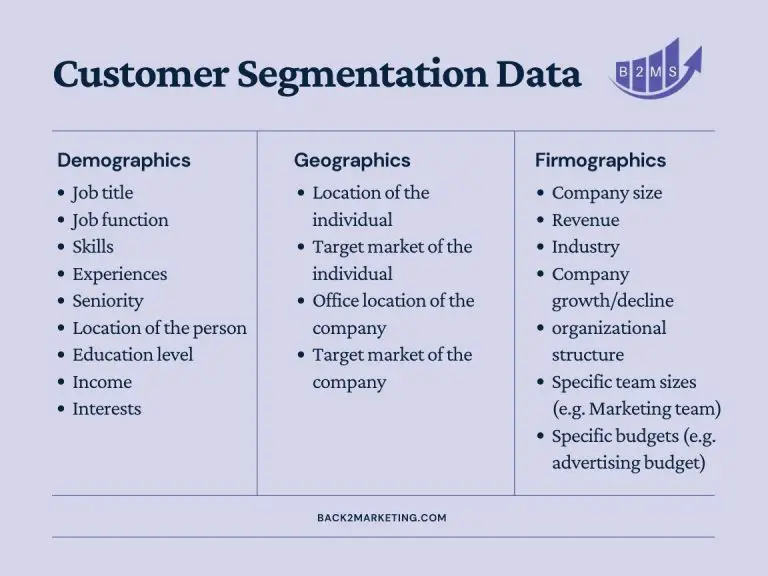Cluster analysis examples for customer segmentation
What is cluster analysis for customer segmentation?
Cluster analysis is a process of dividing a set of objects into groups. The goal of cluster analysis is to reveal hidden patterns and relationships between the data. Thus, in the technique of clustering, homogeneous groups of customers or clusters are formed.
Organizations can use cluster analysis to divide customers into marketing segments. This allows organizations to drill down into the needs and wants of each customer segment, which can lead to more personalized service offerings and increased revenue.
Often, entirely new insights into customer segments emerge – in both positive and negative ways. What do I mean by this?
Positive insights are the uncovering of new target groups. Negative ones, on the other hand, should not be promoted further. For example, you have also focused on a certain industry, but according to the cluster analysis, it should not be in focus at all.
Types of cluster analysis
There are different types of cluster analysis. The two most common are hierarchical and k-mean analysis.
Hierarchical clustering begins by grouping customers based on their similarities and certain characteristics before repeating the process at each successive level until the desired clustering level is reached. An example of hierarchical cluster analysis would be the division into industries and sub-industries.

K-mean clustering is similar but starts with k groups before determining the most appropriate number of clusters based on statistical tools such as the minimum variance between group means or average distances within the group.
In k-mean clustering, a random mean is taken for k clusters. In the next step, each data point is assigned a cluster based on the smallest difference from the midpoint. Then the midpoint for each cluster is calculated and the process is repeated.
Thus, the midpoint is always re-determined to obtain the smallest possible differences from each data point to the respective cluster midpoint. The process ends when the center points no longer change. This process is also called partitioning or centroid clustering.

Cluster analysis examples
How can cluster analysis help with customer segmentation and targeting in marketing?
Customer clusters can be formed based on a variety of data points. Below are six examples:
Purchase behavior
A distinction can be made based on buying behavior. This can be very clear, e.g. online vs in-person, but also a bit more complex. Personalized customer demo or free trial for SaaS solutions, lead gen channel (inbound vs outbound, Google PPC vs Organic SEO, content marketing/blog posts vs solution pages, etc.).
In addition, the number of people involved in a purchase decision, closing time from the first conversation to signing the deal, or contract parameters (trial vs contract signing, annual term vs month-to-month, etc.).
Price
If there are different price segments, it is essential to analyze who buys which product or service.
Firmographic data
A traditional cluster analysis can be performed based on firmographic data for B2B customer segmentation such as the number of employees, revenue, industry, or location.

External factors
In the previous methods, the data is often available in the company’s own database: Time to close, lead source, firmographics, solution sold, etc. The external factors are the segmentation based on the offers of your customers.
Target group of the customer
Does your customer sell B2B or B2C products or services? If you offer a software solution and therefore probably operate in the B2B area, it does not mean that your customers also sell to other companies.
In addition to B2B and B2C, there are further distinctions such as industries or company sizes.
Products & services offered by the buyer
On the basis of product/service categories, further clusters can be subdivided. For example, the keywords of your customer’s website can be analyzed. Tools such as SEMRush can give you insight into which keywords your customer is ranking for organically, as well as PPC advertising.
Active markets of the customer
Your customers may be based in the United States or Canada and thus be in your target market, but they themselves serve other regions. Often locations of the companies help as indicators. If a company has offices in Hong Kong, it can be assumed that they want to penetrate the Asian market.

Sascha is a Lifecycle Marketing Consultant with over 8 years of digital marketing experiences in Silicon Valley, the UK, and Germany.
After leading the demand generation for a 100+ million company, he decided to venture out on himself. He’s now helping clients to attract and convert more leads and customers.
His main focus are SEO, paid media & marketing automation – all with the focus to tie marketing campaigns to revenue.
Sascha has been featured in industry publications.




